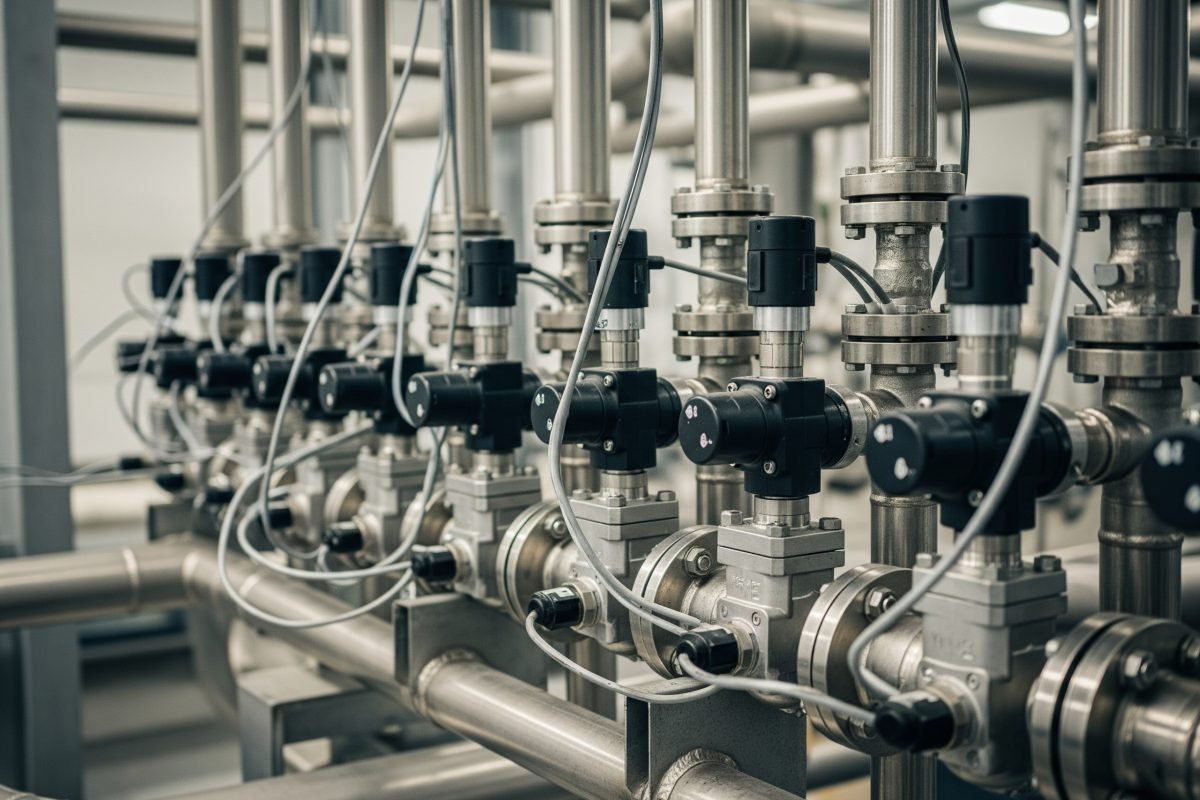솔레노이드 밸브 | 전기 신호를 사용하여 빠르고 정확한 자동화를 위해 공기 흐름을 제어합니다. 파일럿 작동식 및 직동식 솔레노이드 밸브의 전체 제품군을 살펴보세요. 공압 시스템의 핵심 제어 구성 요소로서 전기 신호를 공압 명령으로 변환하여 실린더 및 기타 구성 요소를 빠르고 안정적으로 작동시킵니다. 복잡한 자동화 시퀀스 및 고빈도 작업을 실행하는 데 이상적인 선택입니다. 지금 바로 용도에 맞는 솔레노이드 밸브를 선택하세요.
프로젝트에 필요한 제품이 필요하신가요?
소싱이 어려울 수 있다는 것을 잘 알고 있습니다.
고유하거나 찾기 어려운 구성 요소도 주저하지 말고 양식을 작성하여 문의 사항을 제출하고 원하는 맞춤형 솔루션을 받아보세요! 일반적인 솔루션은 잊어버리세요. 고객의 정확한 요구 사항을 파악하고 꼭 맞는 결과를 제공하는 데 특화되어 있습니다.
고성능 솔레노이드 밸브로 탁월한 자동화를 실현하세요. 빠른 응답과 안정적인 작동을 위해 설계된 당사의 솔레노이드 밸브는 공압 시스템의 공기 흐름을 제어하여 다양한 산업 응용 분야에서 최적의 효율성과 생산성을 보장하는 스마트한 선택입니다.
정확한 공기 흐름 관리와 최적화된 사이클 속도를 위해 빠른 전환 시간으로 즉각적인 제어를 경험하세요.
내구성이 뛰어난 소재와 견고한 설계로 제작되어 일관된 성능과 긴 서비스 수명으로 가동 중단 시간을 최소화합니다.
다양한 산업 제어 요구 사항에 맞는 다양한 기능(2방향, 3방향, 5방향), 크기 및 코일 옵션을 제공합니다.

솔레노이드 밸브는 전기 기계적으로 작동하는 장치입니다. 코일(솔레노이드)을 통한 전류를 사용하여 자기장을 생성하여 플런저 또는 스풀 메커니즘을 작동시킵니다. 이 동작은 밸브 포트를 열거나 닫아 공압 시스템에서 공기 또는 기타 유체의 흐름을 제어합니다.
에너지 효율적인 코일 설계로 전력 사용량과 발열량을 줄여 비용을 절감하고 코일 수명을 연장합니다.
고급 알루미늄, 황동 또는 스테인리스 스틸로 제작되었으며 다양한 작동 조건 및 미디어와의 호환성을 위해 고품질 씰이 장착되어 있습니다.
최적화된 내부 통로를 통해 최대 유량(Cv)과 최소 압력 강하를 보장하여 시스템 효율성을 향상시킵니다.
특정 제어 시스템 요구 사항에 맞게 다양한 AC 및 DC 코일 전압(예: 24VDC, 110VAC, 220VAC)으로 제공됩니다.
예: M5, 1/8인치, 1/4인치, 3/8인치, 1/2인치 등, 유량 용량에 따라 결정됩니다.
예: 2/2 NC, 3/2 NO, 5/2 단일 솔레노이드, 5/2 이중 솔레노이드, 5/3 중앙 폐쇄.
밸브가 안정적으로 작동할 수 있는 최소 및 최대 압력입니다.
예: 24VDC, 110VAC, 220VAC, 전력 소비량(와트 또는 VA).
밸브의 공기 통과 용량을 나타내며, Cv가 높을수록 유량이 많다는 의미입니다.
전원 공급/전원 차단 후 밸브가 전환되는 데 걸리는 시간입니다.
용도에 따라 알루미늄, 황동, 스테인리스 스틸 또는 엔지니어링 플라스틱으로 제작할 수 있습니다.
열악한 환경에서 중요한 먼지 및 물 침투에 대한 보호 기능을 나타냅니다.
자세한 매개변수는 개별 제품 설명서 또는 기술 전문가와 상담하세요.

공압 실린더 작동, 공압 공구 제어, 자동화 기계의 공기 흐름 관리.

분류, 전환, 자재 취급 및 기타 다양한 자동화 제조 단계에 사용됩니다.

케이스 설치기, 필러, 실러, 라벨러 및 팔레타이저의 다양한 공압 기능을 제어합니다.

화학 처리, 수처리, 발전 등 다양한 산업 공정에서 공기 흐름을 조절합니다.

조립 라인, 로봇 공학, 도장 시스템 및 다양한 공압 공구에서 활용됩니다.

원사 텐셔닝이나 잉크 공급 등 다양한 기계 작동을 위한 정밀한 공기 제어 기능을 제공합니다.
유지보수 또는 문제 해결을 시도하기 전에 항상 시스템의 압력을 낮추고 전원을 차단하세요.
직동식 솔레노이드 밸브: 솔레노이드 플런저는 메인 밸브 오리피스를 직접 열거나 닫습니다. 작동을 위해 최소 작동 압력이 필요하지 않습니다.
파일럿 작동 솔레노이드 밸브: 시스템 라인 압력을 사용하여 메인 밸브 작동을 지원합니다. 솔레노이드는 작은 파일럿 오리피스를 제어한 다음 라인 압력을 사용하여 메인 밸브 스풀 또는 다이어프램을 이동합니다.
코일 전압은 제어 시스템에서 공급하는 전압과 일치해야 합니다. 솔레노이드 밸브의 일반적인 산업용 제어 전압은 다음과 같습니다:
잘못된 전압을 사용하면 코일이 손상되거나(너무 높을 경우) 밸브가 안정적으로 작동하지 않을 수 있습니다(너무 낮을 경우). 항상 제어 시스템의 출력 사양과 밸브의 데이터시트를 확인하세요. 또한, 특히 여러 개의 밸브에 동시에 전원이 공급되는 경우 전원 공급 장치가 부하를 처리할 수 있는지 확인하기 위해 전력 소비량(DC의 경우 와트, AC의 경우 VA)을 고려하세요.
2/2방향 솔레노이드 밸브(포트가 2개이고 위치가 열림 또는 닫힘 두 가지)의 경우:
선택은 애플리케이션의 페일 세이프 요구 사항에 따라 달라집니다. 예를 들어, 전원이 차단되면 실린더가 후퇴하거나 프로세스가 중지되도록 하려면 익스텐션을 제어하는 NC 밸브와 스프링 리턴 실린더를 선택할 수 있습니다.
많은 범용 공압 솔레노이드 밸브는 윤활된 공기와 호환되도록 설계되었습니다. 그러나 고려 중인 특정 밸브 시리즈에 대한 제조업체의 사양을 확인하는 것이 중요합니다.
윤활 호환성 및 요구 사항에 대한 지침은 항상 제품 설명서를 참조하세요.
솔레노이드 밸브 고장의 일반적인 원인은 다음과 같습니다:
적절한 공기 여과, 올바른 전기 설치, 지정된 매개변수 내에서 작동하는 것이 대부분의 고장을 예방하는 핵심입니다.
정밀도, 속도 및 신뢰성이 작업에서 만들어내는 차이를 경험해 보십시오. 엔드레스하우저의 광범위한 솔레노이드 밸브는 가장 까다로운 산업 요구 사항을 충족하도록 설계되었습니다. 지금 바로 귀사의 요구에 맞는 완벽한 밸브를 찾아보세요.
디자인 및 개발.
혁신적이고, 다재다능하며, 힘을 실어주는 공압의 우수성을 엔지니어링합니다.
당사의 전담 공압 전문가는 프리미엄 공압 제품을 제공하는 데 중점을 둡니다.
를 사용하여 시스템에 최적의 기능을 보장합니다.
빠른 링크
